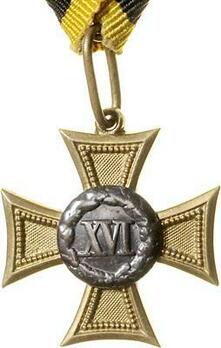Military Long Service Decoration, Type I, II Class for NCOs (for 16 years)
CATEGORY: Version
SKU: 02.AUT.0122.104.01.000
Estimated market value:

Estimated market value:
The Long Service Decoration was founded by Emperor Franz Joseph I in 1849. It was to reward Officers, Non-Commissioned Officers and enlisted men in the Austrian Army and Navy for long service. Conscription began in 1780, meaning each male citizen in the crown lands could be called up for military service, however several exceptions existed. The number of years required to serve and rules of conscription changed frequently, from 14 years in 1811, to 8 years in 1845, to 10 in 1852.
In 1859, all other ranks that completed their mandatory service and remained in the army were awarded with a grenade of white cloth to wear on their uniform tunic. These individuals were provided the name “Grenadier” in the infantry or “Veteran” in all other branches. This practice ceased in 1869, and the grenades were replaced with chevrons of golden silk on the left sleeve.
In 1868, the Defence Act was passed, making it compulsory for all male citizens to serve twelve years in the army. This consisted of three years in the active service, seven years in the reserves and to in the Austrian/Hungarian cavalry mounted artillery or navy the reserve period was reduced by one year.
In 1867, there were changes to the regulations. The I Class was to be awarded for 12 years, and the II Class for 18 years. Later, eligibility for the II Class extended from 18 years to 24 years and the medallion was changed to XXIV.
In 1890, another change to the statues was introduced. The decoration was now awarded in three classes. I Class for 50 years, II Class for 40 years, and III Class for 25. The Long service cross for other ranks was altered to be 24 years for I Class and 12 years for II Class.
In 1913, the other ranks medals were altered to be in three classes. The I Class for 20 years, II Class for 10 years and II Class for 6 years. At the same time, it was decided that the II Class for Officers would be awarded after 35 years of service.
Eligibility was expanded in 1914 to include engineers and artillery engineers and in 1917 to military doctors.
Due to the large number awarded, it is very difficult to trace the number of decorations over the course of it’s lifetime. There are many manufacturing differences (size, composition, visual changes in the obverse medallion) as many firms created the decorations. The decoration ceased to exist after 1918.
The Type I Medals (1849-1867) were awarded to officers and one to other ranks. The obverse medallion of the award for Officers in Type I presents a double headed eagle without crowned heads, but with one larger crown above both heads.
The crosses for officers were gold plated and, instead of numbers show either a silver double headed eagle (I Class, for 25 years) or a gold-plated double headed eagle (II Class, 50 years).
For other ranks, the I Class was awarded for 8 years had a bronze central medallion with the number VIII. The II Class was awarded for 16 had a silver central medallion with a laurel wreath and the number XVI.
The decoration was worn on a yellow and black striped ribbon.

Comments
Sign in to comment and reply.


Scroll Top